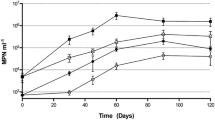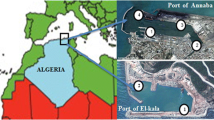Abstract
Kuwaiti habitats with two-decade history of oil pollution were surveyed for their inhabitant oil-utilizing bacterioflora. Seawater samples from six sites along the Kuwaiti coasts of the Arabian Gulf and desert soil samples collected from seven sites all over the country harbored oil-utilizing bacteria whose numbers made up 0.0001–0.01% of the total, direct, microscopic counts. The indigenous bacterioflora in various sites were affiliated to many species. This was true when counting was made on nitrogen-containing and nitrogen-free media. Seawater samples harbored species belonging predominantly to the Gammaproteobacteria and desert soil samples contained predominantly Actinobacteria. Bacterial species that grew on the nitrogen-free medium and that represented a considerable proportion of the total in all individual bacterial consortia were diazotrophic. They gave positive acetylene-reduction test and possessed the nifH genes in their genomes. Individual representative species could utilize a wide range of aliphatic and aromatic hydrocarbons, as sole sources of carbon and energy. Quantitative determination showed that the individual species consumed crude oil, n-octadecane and phenanthrene, in batch cultures. It was concluded that the indigenous microflora could be involved in bioremediation programs without bioaugmentation or nitrogen fertilization. Irrigation would be the most important practice in bioremediation of the polluted soil desert areas.





Similar content being viewed by others
References
Ali N, Dashti N, Al-Mailem D, Eliyas M, Radwan S (2012) Indigenous soil bacteria with the combined potential for hydrocarbon-consumption and heavy metal-resistance. Environ Sci Pollut Res 93:113–120
Al-Mailem D, Sorkhoh N, Salamah S, Eliyas M, Radwan SS (2010) Oil-bioremediation potential of Arabian Gulf mud flats rich in diazotrophic hydrocarbon-utilizing bacteria. Int Biodeter Biodegr 64:218–225
Al-Mailem D, Al-Awadhi H, Sorkhoh NA, Eliyas M, Radwan SS (2011) Mercury resistance and volatilization by oil utilizing haloarchaea under hypersaline conditions. Extremophiles 15:39–44
Al-Sarawi HA, Mahmoud HM, Radwan SS (2008) Pyruvate-utilizing bacteria as contributors to the food web in the Arabian Gulf. Mar Biol 154:337–381
Altschul SF, Madden TL, Schäffer AA, Zhang J, Zhang Z, Miller W, Lipman DJ (1997) Gapped BLAST and PSI-BLAST: a new generation of protein database search programs. Nucleic Acids Res 25:3389–3402
Anon (1979) BP statistical review of the world oil industry. British Petroleum Company, London
Atlas RM (1995) Hand book of media for environmental microbiology. CRC Press, Boca Raton, FL, pp 32–33, 237–238
Church MJ, Björkman KM, Karl DM (2008) Regional distributions of nitrogen-fixing bacteria in the Pacific Ocean. Limnol Oceanogr 53:63–77
Dashti N, Khanafer M, Ali N, El-Nemr I, Sorkhoh N, Radwan S (2009) The potential of oil-utilizing bacterial consortia associated with legume root nodules for cleaning oily soils. Chemosphere 74:1354–1359
Duarte CM, Vaqué D (1992) Scale dependence of bacterioplankton patchiness. Mar Ecol Prog Ser 84:95–100
Eckford R, Cook FD, Saul D, Aislabie J, Foght J (2002) Free-living heterotrophic nitrogen-fixing bacteria isolated from fuel contaminated Anarctic soils. Appl Environ Microbiol 68:5181–5185
El Samra MI, Emara HI, Shunbo F (1986) Dissolved petroleum hydrocarbons in the Northwestern Arabian Gulf. Mar Pollut Bull 17:65–68
Hardy RWF, Holsten RD, Jackson EK, Burns RC (1968) The acetylene-ethylene assays for N2 fixation: laboratory and field evaluation. Plan Physiol 13:1185–1207
Hunter JR (1982) The physical oceanography of the Arabian Gulf: a review and theoretical interpretation of previous observations. In: Halwagy R, Clayton D, Behbehani M (eds) The first Arabian Gulf conference on environment and pollution. Kuwait University, Faculty of Science, Kuwait, pp 1–23
Klug MJ, Markovetz AJ (1971) Utilization of aliphatic hydrocarbons by microorganisms. Adv Microb Physiol 5:1–43
Kreig NR, Holt JG (1984) Bergey’s manual of systematic bacteriology, vol 1(2). Williams and Wilkins, Baltimore
Leahy JG, Colwell RR (1990) Microbial degradation of hydrocarbons in the environment. Microbiol Rev 54:305–315
Long RA, Farooq A (2001) Microscale patchiness of bacterioplankton assemblage richness in seawater. Aquat Microb Ecol 26:103–113
Marchand M, Monfort JP, Rubio AC (1982) Distribution of hydrocarbons in water and marine sediments after the Amoco Cadez and Istoc. 1. Oil spills. In: Keith L (ed) Energy and environmental chemistry, vol 1. Arbor Science, Michigan, pp 487–509
McKinnon M, Vine P (1991) Tides of war: eco-disaster in the gulf. Boxtree Limited, London
Musat F, Harder J, Widdel F (2006) Study of nitrogen fixation in microbial communities of oil contaminated marine sediment microcosms. Environ Microbiol 8:1834–1843
Perez-Vargas J, Poggi-Varaldo HM, Calva–Calva G, Rios-Leal E, Rodriguez-Varquez R, Ferrera-Cerrato R, Esparza-Garcia F (2000) Nitrogen-fixing bacteria capable of utilizing kerosene hydrocarbons as a sole carbon source. Water Sci Technol 42:407–410
Poly F, Monrozier LJ, Bally R (2001) Improvement in the RFLP procedure for studying the diversity of nifH genes in communities of nitrogen fixers in soil. Res Microbiol 152:95–103
Prantera MT, Drozdowicz A, Leite SG, Rosado AS (2002) Degradation of gasoline aromatic hydrocarbons by two N2-fixing soil bacteria. Biotechnol Lett 24:85–89
Radwan SS (2008) Microbiology of contaminated desert soils and coastal areas in the Arabian Gulf. In: Dion P, Nautiyal CS (eds) Microbiology of extreme soil. Soil biology, vol 13. Springer Verlag, Berlin, pp 275–298
Radwan SS (2009) Phytoremediation for oily desert soil. In: Singh A, Kuhad RC, Ward OP (eds) Advances in applied bioremediation. Springer, Berlin
Radwan SS, Sorkhoh NA, El-Nemr IM, El-Desouky A (1997) A feasibility study on seeding as a bioremediation practice for the oily Kuwaiti desert. J Appl Microbiol 83:353–358
Santegoeds CM, Ferdelman TG, Muyzer G, Beer DD (1998) Structural and functional dynamics of sulfate-reducing populations in bacterial biofilms. Appl Environ Microbiol 64:3731–3739
Sen Gupta R, Kureishy TW (1981) Present stage of oil pollution in the northern Indian Ocean. Mar Pollut Bull 12:295–301
Seuront L, Gentilhomme V, Lagadeuc Y (2002) Small-scale nutrient patches in tidally mixed coastal waters. Mar Ecol Prog Ser 232:29–44
Seymour JR, Mitchell JG, Pearson L, Waters RL (2000) Heterogeneity in bacterioplankton abundance from 4.5 millimetre resolution sampling. Aquat Microb Ecol 22:143–153
Sorkhoh NA, Ghannoum MA, Ibrahim AS, Stretton RJ, Radwan SS (1990) Crude oil and hydrocarbon degrading strains of Rhodococcus rhodochrous isolated from soil and marine environments in Kuwait. Environ Pollut 65:1–17
Sorkhoh NA, Ali N, Al-Awadhi H, Dashti N, Al-Mailem DM, Eliyas M, Radwan SS (2010a) Phytoremediation for mercury in pristine and crude oil contaminated soils: contributions of rhizobacteria and their host plants to mercury removal. Ecotoxicol Environ Saf 64:659–664
Sorkhoh NA, Ali N, Dashti N, Al-Mailem DM, Eliyas M, Radwan SS (2010b) Soil bacteria with the combined potential for oil-utilization, nitrogen-fixation and mercury-resistance. Inter Biodeter Biodegr 64:226–231
Swofford DL (1998) PAUP*. Phylogenetic analysis using parasimany (* and other methods), version 4b10. Sinauer Association, Sunderland, MA
Thasavi R, Jayalakshmi S, Radhahrishnan R, Balasubramaman T (2007) Plasmid incidence in four species of hydrocarbonoclastic bacteria isolated from oil polluted marine environment. Biotechnol 6:349–352
Yu W, Dodds WK, Banks K, Skalsky J, Strauss E (1995) Optimal staining and sample storage time for direct microscopic enumeration of total and active bacteria in soil with two fluorescent dyes. Appl Environ Microbiol 61:3367–3372
Zehr JP, McReynold LA (1989) Use of degenerate oligonucleotides for amplification of the nifH gene from the marine cyanobacterium Trichodesmium thiebautii. Appl Environ Microbiol 55:2522–2526
Acknowledgments
This work has been supported by Kuwait University, Research Grant SL01/08. Thanks are due to SAF Analysis Facility for the support provided through GS 01/02, ABI 3130 × 1 Genetic Analyzer, GS 02/01, Varian 3600 GLC equipment and GS 01/05, ICP-MS (Varian 820-MS).
Author information
Authors and Affiliations
Corresponding author
Additional information
Communicated by Jan Roelof van der Meer.
Rights and permissions
About this article
Cite this article
Al-Awadhi, H., Al-Mailem, D., Dashti, N. et al. Indigenous hydrocarbon-utilizing bacterioflora in oil-polluted habitats in Kuwait, two decades after the greatest man-made oil spill. Arch Microbiol 194, 689–705 (2012). https://doi.org/10.1007/s00203-012-0800-7
Received:
Revised:
Accepted:
Published:
Issue Date:
DOI: https://doi.org/10.1007/s00203-012-0800-7




